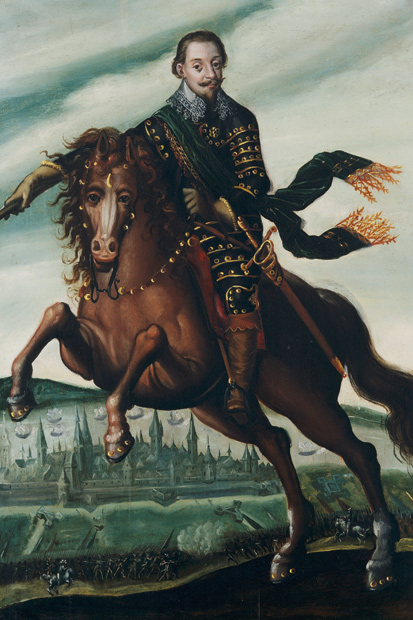Historians have generally not been kind in their assessment of Britain’s first two Stuart kings. Their political skills are regarded as meagre; their objectives malign; their one undisputed talent an unerring ability to alienate their subjects — with rebellion and civil war as the result. To his credit, Tim Harris, in his formidably large and well-researched new ‘study of the kingship’ of James I and Charles I, raises a voice in dissent. He is by no means blind to the Stuarts’ failings: James’s profligacy, and fondness for the sound of his own voice; Charles’s unbending self-righteousness and notorious aloofness from his subjects and even his own court. Yet he also makes a case for their virtues: their vision and courage; their high sense of duty; their accomplishments in the face of challenges that would have daunted even the greatest of the Tudors.
For the composite realm created when James of Scotland succeeded the childless Elizabeth in 1603 was an inherently unstable amalgam. His three kingdoms of England, Ireland, and Scotland had no common language, no shared institutions besides the monarchy, no uniformity in religion. Rival confessional camps in each of his kingdoms maintained strong loyalties to the centres of Catholic and Protestant faith on the continent, and took a keen interest in their fortunes. Harris is unusually sympathetic in his treatment of the Stuarts’ attempts to grapple with this fractured inheritance, and particularly adept at explaining the fissures and tensions in early 17th-century Ireland and Scotland. It is here that Rebellion makes its most significant contribution to our understanding of this volatile period.
Of course, few would now deny that the billiard-ball-like interactions between the Stuart kingdoms in the late 1630s did much to create the momentum that propelled the most powerful and populous of the three, England, into civil war. Yet until Scotland rebelled in 1637, few English people knew or cared very much about events in the other Stuart kingdoms. What really excited and alarmed them was the fate of the Protestant cause in the Thirty Years War (1618-48): the great pan-European conflict in which the very survival of ‘reformed religion’ seemed at stake. And it is in dealing with this European dimension that Harris’s story falls notably short.
The promise on the dust-jacket that this book will pay ‘due attention to the broader European and Atlantic contexts’ is left conspicuously unfulfilled. Due attention to the European context would demand some mention of Sweden’s warrior king Gustavus Adolphus, whose armies came close to destroying Catholic power in Germany during the early 1630s, and whose campaigns and eventual death in battle roused the British public’s admiration far more than any feat of the Stuarts.
It would also relate Charles’s ‘unparliamentary’ levy of Ship Money in the 1630s not merely to issues of domestic finance and constitutional propriety, but also to the titanic struggle taking place between the Dutch, French, and Spanish for control of Channel, in which Charles was desperate to intervene. And it would require at least passing reference to the strong influence of the Madrid- and Vienna-based branches of the Habsburg monarchy upon Stuart court culture.
The Atlantic context likewise receives short shrift. Colonial affairs are particularly revealing of Stuart kingcraft, and of the potential for political opposition, even armed resistance, to their rule. Unfortunately, Harris shrinks this oceanic dimension to pond-like proportions. Much more could have been made, for example, of the considerable policy overlap between royal initiatives to impose ‘one uniforme Course of Government’ on the American colonies, and Charles’s insistence in 1637 on foisting an Anglicised and ‘popish’ prayer book on his outraged Scottish subjects — which set the wheels of rebellion in motion throughout his realm. Charles’s leading Puritan opponents certainly made this connection. And the cannon that they installed in their fort at Saybrook, in present-day Connecticut, in the 1630s were primarily intended to repel royal, not foreign, aggression.
By underestimating the anger and humiliation felt in Britain by the Stuart kings’ failure to uphold the Protestant cause abroad, Harris comes to the highly questionable conclusion that ‘consensus’ prevailed in England, even as late as 1641, and that no one favoured a fundamental restructuring of the state. This contention is all the more puzzling given his apparent familiarity with recent scholarship on ‘opposition’ schemes to challenge Habsburg power, for these prescribed precisely the kind of big-taxing parliamentary state that would subsequently bring Charles to defeat in the civil war and to the scaffold in 1649.
The parliamentarian grandees who initiated this revolution in government after 1640 included a number of high-ranking ex-courtiers — a revealing phenomenon that, like the court itself, Harris all but ignores — and they were driven to rebellion as much by what their kings had not done as by what they had. The Stuarts’ sins of omission were grievous. They had not sent battle fleets to the New World; they had not defended ‘reformed religion’ in the Old; and they had not listened to or worked with the one institution in the British Isles capable of raising sufficient revenue to make such ventures possible: the English Parliament.
Rebellion is a brave attempt to master a highly complex subject, but like the Stuarts’ endeavours to put their own house in order, it rests on flawed foundations.






Comments